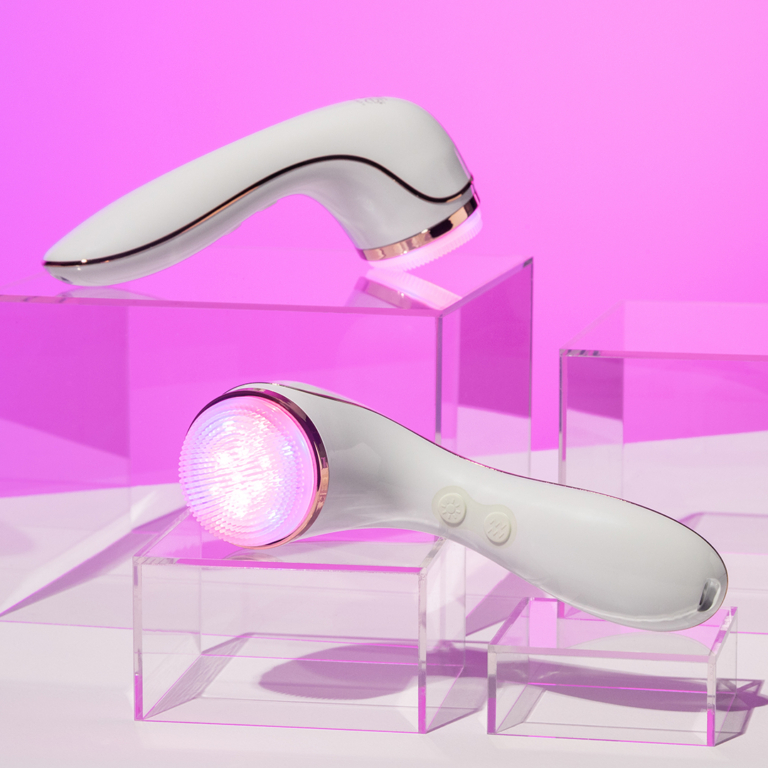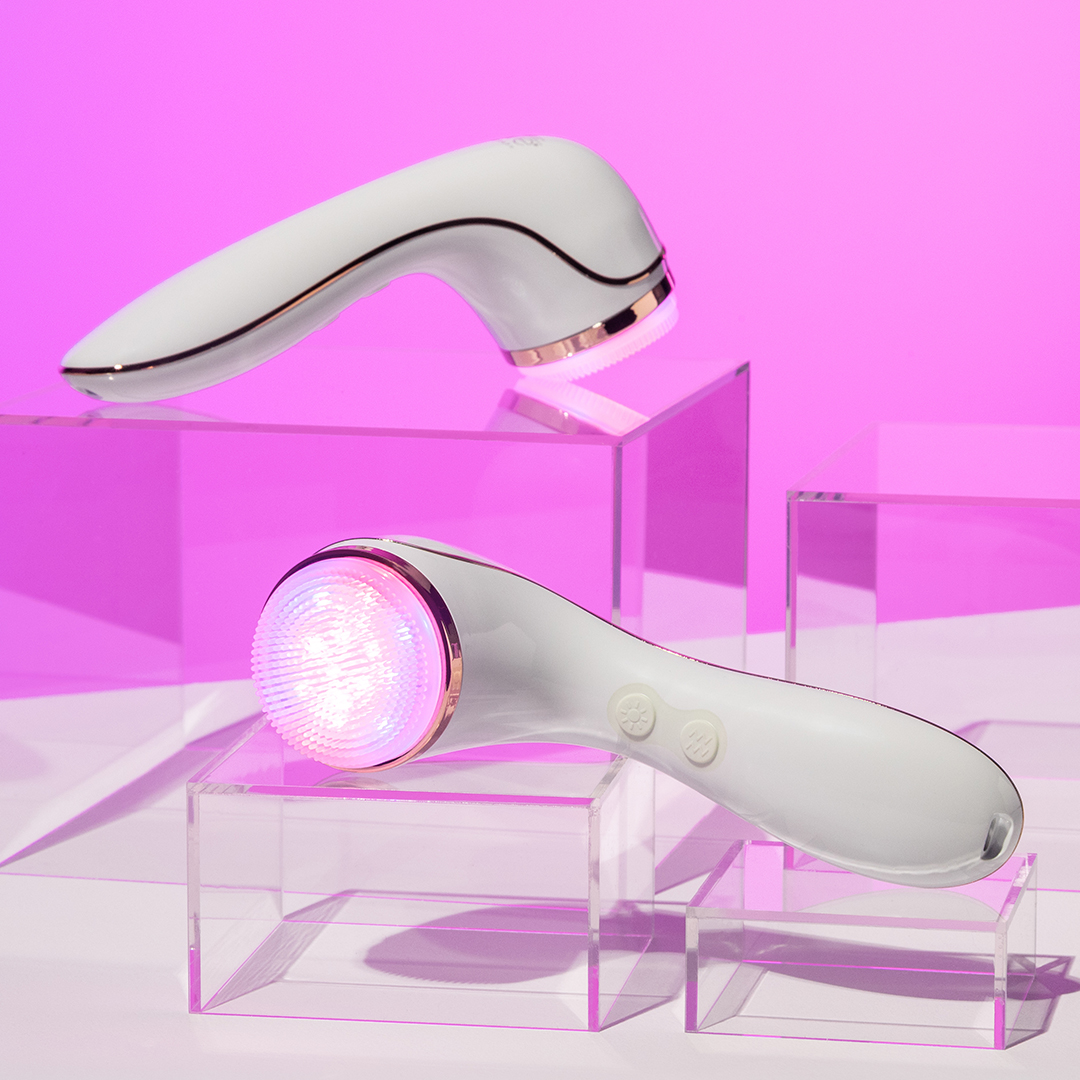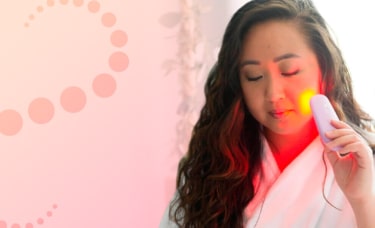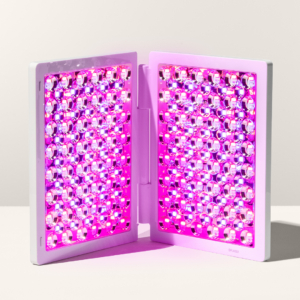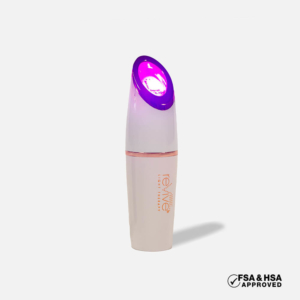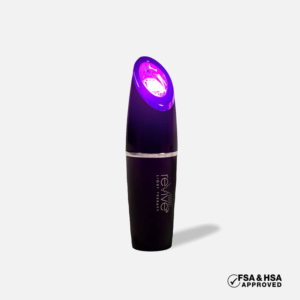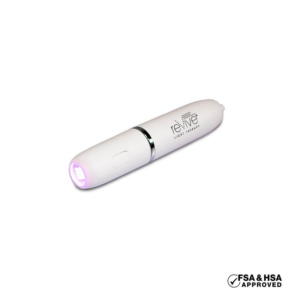How are Red and Blue Light Therapy Devices Different?
When choosing a light therapy device, one of the first decisions you’ll need to make is choosing the LED color. Red light therapy and blue light therapy both offer convenient, clinical-strength skincare treatments you can administer at home. However, different wavelengths of LED light, from infrared to blue, provide different benefits for a range of health and beauty applications.
Before investing in a home light therapy device, it is important to understand what each LED color treats to ensure you select the right device for your unique skincare needs. Continue reading to learn the difference between red light and blue light and their many therapeutic applications.
What Is LED Light Therapy?
LED light therapy is a skincare treatment using various light wavelengths, including red, blue, and infrared. Originally developed by NASA for plant growth experiments, scientists later found it to have applications in wound treatment and bone and muscle loss. LED light therapy does not contain ultraviolet rays, like the sun, making these devices safe for regular use.
Different wavelengths of light have different effects on the cells of the body. In combination, these wavelengths can produce powerful results for your skincare regimen.
Blue Light Therapy vs. Red Light Therapy
Researchers have identified the specific wavelengths of light that exert different effects on the cells of the body. Blue and red light confer beneficial effects on skin cells. Home light therapy tools create these wavelengths with high-power LED microchips. The devices also eliminate harmful and non-productive light wavelengths, such as UV rays present in sunlight, delivering only safe light wavelengths.
These non-UV light therapy devices feature Deep Penetrating Light (dpl®) technology to penetrate the skin safely. When it comes to the functions of blue light versus red light, blue light destroys acne-causing bacteria, while red light reduces inflammation and increases circulation.
Keep reading to learn more about red light therapy vs. blue light therapy and how these devices work:
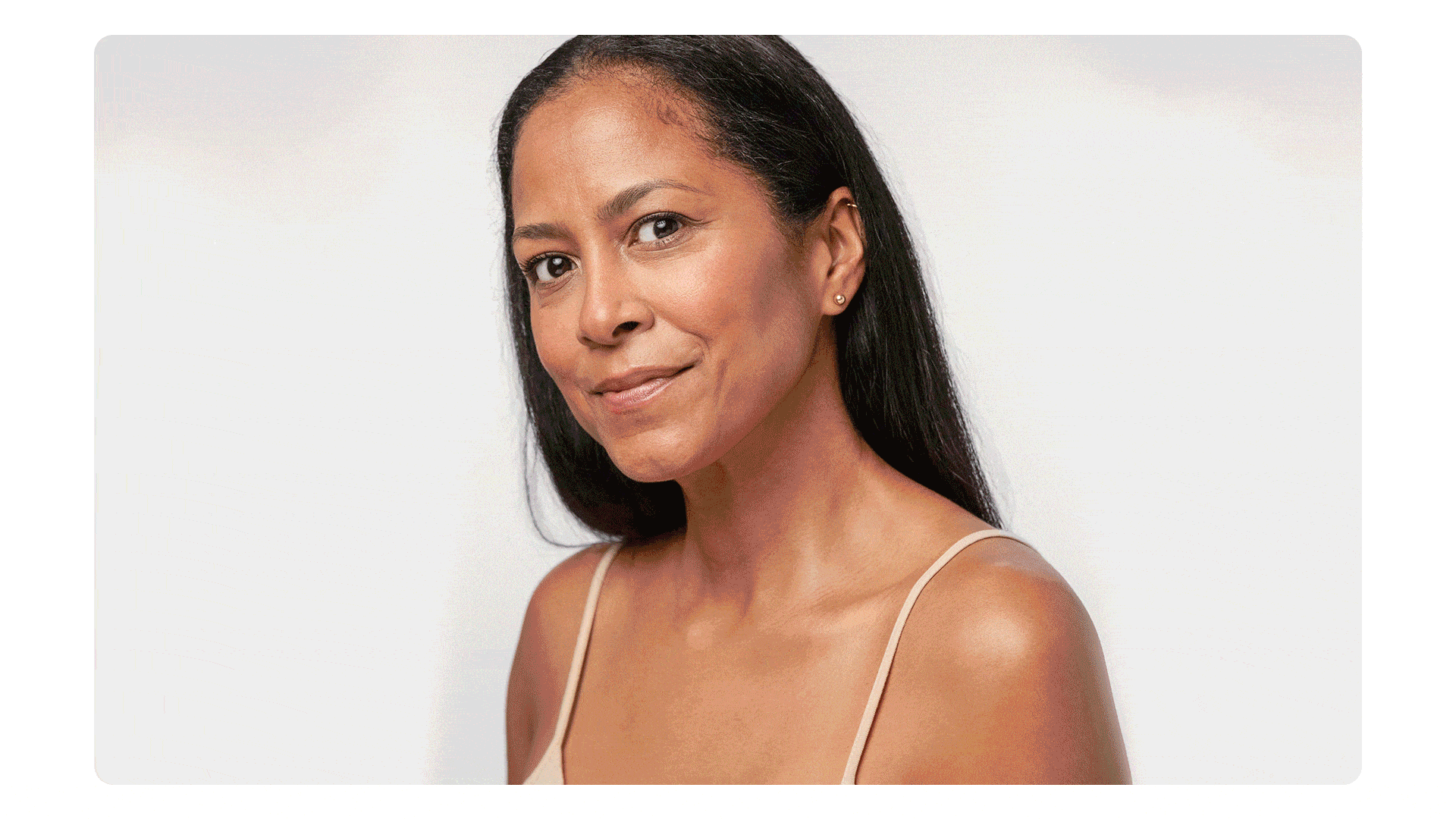
What Is Red Light Therapy?
Red light therapy is a technique that uses low-level wavelengths to refine your skin’s surface. Customers also use this visible form of light therapy to treat other medical conditions. Research is ongoing, but many studies reveal the effectiveness of red light therapy for clinical uses.
NASA first experimented with red light therapy for growing plants while in space. Scientists discovered the light from red light-emitting diodes (LEDs) helped promote growth and photosynthesis in plants. This research evolved into healing astronauts’ wounds and investigating other potential uses for red light therapy.
Today, red light therapy has many applications, from increasing blood circulation to minimizing scars and reducing wrinkles.
Scientists believe that red light therapy works by strengthening mitochondria in the body’s cells. Mitochondria are responsible for producing the energy necessary for the cell’s functioning and survival. Most of the energy mitochondria make is housed in a molecule called adenosine triphosphate (ATP), which helps the body store and use energy. By providing more energy through the light therapy, cells can work more efficiently to repair skin, enhance skin rejuvenation or boost new cell production.
What Is Blue Light Therapy?
Blue light therapy uses light to treat acne and other skin imperfections. Since it can only treat areas the light can reach, it typically treats conditions on or just below the skin’s surface. Scientists have proven blue light therapy helps manage acne because the rays destroy P. acnes bacteria. They may also reduce inflammation of keratinocytes, common cells in the outer layer of the skin.
What Is Blue Light Therapy Used to Treat?
Blue light therapy has several therapeutic uses. Dermatologists might use blue light to treat and prevent acne, reduce inflammation and minimize skin discoloration.
In our in-house, two-week consumer study, 100% of participants saw improvements in three to four of the following areas:
- Improvement of skin tone
- Reduction of pores
- Improvement of skin texture
- Overall skin condition
Blue light causes our sebaceous glands to produce less oil, clear the skin and decrease other acne symptoms like redness and inflammation. It works best on traditional acne typical of a breakout, making it effective for spot treatments and flare-ups. Others use it to treat long-term acne on larger areas of the face, back or body.
Devices that use both blue and red light might also help reduce acne, which can ultimately prevent scarring from occurring.
What’s the Difference Between Red and Blue Light Therapy?
The difference in red light and blue light therapy lies within their wavelengths. Because red and blue light have different wavelengths, they also have different effects on the skin.
Light with longer wavelengths can reach deeper parts of the body. Red light therapy penetrates the skin to stimulate collagen and reduce inflammation. Meanwhile, blue light helps treat skin conditions like acne, penetrating the pores and destroying bacteria. Infrared light, meanwhile, penetrates deeply into the muscles to help with pain and stiffness.
Is Red or Blue Light Better for You?
Both red and blue light therapy devices are safe, non-invasive, and all-natural. Blue light therapy has shown promising results in treating people with acne. On the other hand, red and infrared light increase circulation and relieve pain caused by arthritis and other conditions.
When it comes to blue light vs. red light for skin and acne, combining the two light therapies can produce the best results. Doctors and dermatologists often use the two spectrums together since they complement one another. Here are some of the conditions that red and blue light therapy, together, can help treat:
- Acne
- Inflammation
- Signs of aging, including age spots and wrinkles
- Wound healing
- Oral health
- Other skin conditions caused by inflammation
These light therapy devices can also minimize scarring and improve lesions. A 2021 study showed that blue light therapy was safe and effective in reducing lesions caused by eczema.
Combining red and blue light therapy can efficiently treat acne. The blue light destroys bacteria, and the red light lessens inflammation and accelerates healing.
reVive Light Therapy™ and dpl® at-home devices use red, blue, or multiple colors of light technology to treat some of the most stubborn skin conditions. All you need is a few minutes in your day to get healthier, younger-looking skin.
Some of our best-selling products that combine red and blue light therapy include:
- reVive Light Therapy™ Clinical Acne Treatment: This treatment device combines red and blue light therapy to provide clean, clear skin and a healthier appearance.
- reVive Light Therapy™ Essentials Acne Treatment: The triangular head on this device makes it easy to get into the contours around your nose and eyes.
- Glō by reVive Light Therapy™ Portable Acne Light Therapy Device: This portable acne light therapy device can be used on the go, making it perfect for your active lifestyle.
Our Lux Collection offers red light anti-aging devices, blue light acne devices and combo red and blue light modes to target specific problem areas. Each device offers cordless operation and a proximity sensor to ensure proper treatment performance, making the Lux Collection an excellent addition to your daily skincare routine.
Which Light Therapy Is Best for Wrinkles?
Infrared light and red light work in combination to rejuvenate aging skin. This light has a longer wavelength, enabling it to penetrate deeper into the skin than blue light.
Collagen fibers consist of elastin and hyaluronic acid, which are responsible for skin elasticity and hydration. As we age, our bodies produce less collagen and our skin becomes drier and less elastic, causing wrinkles.
Red light therapy stimulates the production of collagen and elastin to help cells reproduce faster. As a result, red light can generally reduce and reverse fine lines and wrinkles and promote plumper skin. Red light therapy can also reduce inflammation, sun and age spots and skin discoloration.
Which Light Therapy Is Best for Acne?
Doctors and dermatologists often use blue light therapy to penetrate pores and destroy bacteria, making it an excellent choice for acne treatment. While some bacteria are helpful, others boost oil production and cause blemishes. Blue light destroys acne-causing bacteria, targeting and destroying it to prevent acne and blemishes.
Studies indicate that LED light therapy devices can improve various skin conditions. reVive Light Therapy™ features Deep Penetrating Light (dpl®) technology in our blue light products, allowing light to safely penetrate the skin to treat bacteria in areas many acne treatment topicals can’t reach.
And as stated above, a combination of red and blue light therapy devices can more effectively reduce acne.
Which Light Therapy Is Best for Pain Relief?
Deep red and infrared light therapy provide proven pain relief from injuries or everyday aches. When it comes to red light therapy vs. infrared, the difference is in what you see. While infrared is classified as light energy, we cannot see it, even though we can feel its warmth.
Infrared is safe, natural and easily absorbed by our tissues. Patients who undergo red and infrared light therapy notice increased circulation and blood flow.
Red and infrared light therapy also benefit you by:
- Accelerating healing
- Repairing tissue
- Relaxing muscles
- Relieving pain and stiffness associated with arthritis
- Relieving muscle and joint aches
- Enhancing muscle recovery
Infrared light therapy uses lights with a longer wavelength than red light, allowing it to reach deep inside the body’s muscles. The wavelength can reach muscles, nerves, and even bones. Deep red and infrared light is often used to provide relief from pain and muscle spasms. It also improves oxygen-rich blood circulation in the body, healing deep tissue.
Red light therapy is also excellent in treating pain caused by sports injuries. Both acute and overuse injuries can cause intense pain that requires an athlete to reduce or stop their activity. You can use red or infrared therapy devices as part of a routine workout or on specific injuries that occur on the field or in the gym.
These light therapy devices target all body parts, relieving the head and neck, joints, hands, wrists, and feet, and even improving joint flexibility. It may relieve acute or chronic pain from arthritis, tendinitis, joint injury, bursitis, aches, sprains, strains, and more.
How Often Should I Use My Red or Blue Light Therapy Device?
The guidelines for use are similar for most red and blue light therapy devices. However, if you use blue light, it is recommended to wear goggles when treating around the eyes if the light shines into your eyes.
To maximize skincare results, use the system in one treatment area for three minutes. Hold the device still without moving around. Move to the next treatment location after three minutes. You’ll need to extend the time to 20 minutes for pain treatment,
When you first start red or blue light therapy treatments, try once a day use for the first 45-60 days. After that, you may continue to use the system daily or decrease to two to three times per week, depending on what works for you. Since every person’s skin is unique, light therapy will respond differently depending on the person. We suggest you consult with your preferred health or skincare professional and take before and after photos to monitor your results.
We Provide an Array of Light Therapy Devices That Can Help Relieve Your Problems
Red and blue light therapy devices work in different ways, though they are both helpful in treating various conditions, from chronic pain to skin imperfections. While research is constantly evolving, many report better overall quality of life when using these light therapy devices to manage and improve their conditions.
At LED Technologies, Inc., we enhance our customers’ lifestyles with high-quality, innovative technologies. All our light therapy tools are FDA-cleared, safe, reliable and effective against pain, acne, wrinkles and other skin imperfections. We strive to improve our products and ensure we exceed customer standards of care, quality and satisfaction.
Frequently Asked Questions
Why is FDA clearance important for at-home light therapy skincare devices?
- Safety should be your top priority with any pain relief products you purchase, and this extends to light therapy devices. Light therapy devices need to have FDA clearance in the United States. The FDA has not reviewed devices without clearance for potential safety concerns. All of our LED light therapy products are FDA-cleared. You can feel confident in our commitment to your safety.
Does light therapy use UV wavelengths?
- Red and infrared LEDs produce no UV rays, so there’s no risk of skin cancer like there is from the sun. LED light therapy uses LEDs that emit non-invasive, non-UV wavelengths to promote cellular growth and relieve a range of conditions.
How do I test my skin sensitivity to light therapy?
- Test yourself for light sensitivity prior to initial treatment:
- Power on the device.
- Place the device on or no more than ¼” from the skin on your forearm for 3 minutes.
- After 3 minutes, check the area. If the area has turned red and lasts for more than 2 hours, your skin is light-sensitive. Discontinue use and contact Customer Service at support@ledtechnologies.com
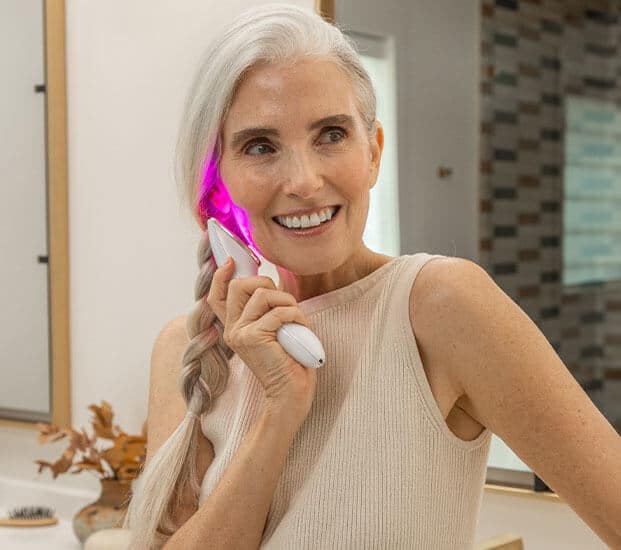
Experience the power of light therapy at home
Specific wavelengths of light have different effects, and can be used for a variety of applications — from destroying acne-causing bacteria to killing harmful germs on your phone. Our light therapy devices allow you to harness the power of LEDs in the comfort of your own home.
See How It Works